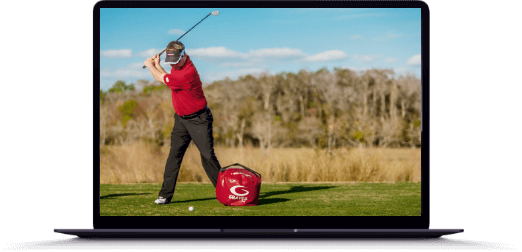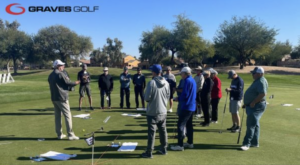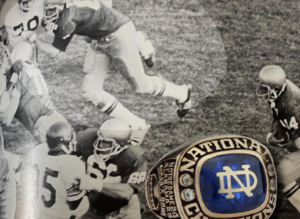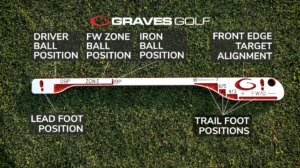RATE YOUR SCORING / PUTTING GAME
By Tim Graves, PGA
Graves Golf Co-Owner
How important do you think putting is to your scoring?
How many of you think you are a good putter, but don’t score as well as you want?
How many of you know how to Rate Your Putting Game?
Fact #1: Over 40% of scoring occurs with the putter in your hand (up to 50% for higher handicap golfers).
Fact #2: The quickest way to reduce your scoring / handicap is to improve your putting.
Fact #3: Most don’t know how to improve their putting… it is more than just going to a green and hitting a few putts…
To determine where you can improve your putting, rate your putting game below:
There are 10 areas of your putting that are critical to having a good / great putting game – each is to be rated on a scale of 0 to 3.
Keep a running count and finally a total of the 10 areas.
EQUIPMENT:
1. Is your putter fit to you for length, lie angle, grip size and weighting?
0 – No, or I don’t know
1 – Partially fit (maybe grip size, not lie angle, etc..)
2 – All but one area fit – ie. length and grip size, lie angle, but not weighting, etc..
3 – My putter was fit perfect for me and can be adjusted as needed (change weighting, adjust lie angle, etc..)
2. Do you practice and play with one type / brand of golf ball?
0 – I play and practice with different golf balls – no one in particular.
1 – I play with one type of golf ball, but practice with different.
2 – Most of the time I practice putt with same ball I play with.
3 – I always practice putt with the same golf ball I play with – Always.
3. Does your putter and golf ball have an alignment system / aid and you use when you putt.
0 – No, I don’t have or don’t use alignments aids on either golf ball or putter.
1 – Yes, one does, one does not (or don’t use).
2 – Yes, both have alignment aids, but I don’t use all the time. (Practice and Play)
3 – Yes, and I use both when I practice and play.
4 – (Extra point) – The alignment aid on my putter MATCHES alignment aid on golf ball.
FUNDAMENTALS:
4. Do you understand how your putting fundamentals (3 Hs of Putting) (Hands leading, hands down the line, hip check) are directly related to your chipping / pitching and your full swing fundamentals?
0 – I have no idea how they are related?
1 – I have heard they are related, but have not studied how they are related.
2 – I know they are related and have watched the “2 Birds with One Stone” instructional information once.
3 – I know they are related, watch the “2 Birds with One Stone” instructional material routinely and use Graves Golf On Demand to study additional information on the different fundamentals and their relationships.
5. Is the golf ball position at set up under your eye line and forward of center?
0 – Don’t know or have never checked
1 – I think so, but have no way to check with current system.
2 – Yes, but ball position can change under pressure or over time without consistent practice.
3 – Yes, it is guaranteed under my eye line and forward of center as my putter is set up to get me in the perfect / ideal position every time.
6. Do you have shaft lean in the putter at set up, at impact and through the stroke?
0 – Don’t know or have never checked
1 – I think so, but have no way to check and / or will break down at impact, through stroke, etc..
2 – Yes, but it will break down when under pressure.
3 – Yes, it is guaranteed as my putter build guarantees shaft flex at set up, impact and through stroke.
6. Do you accelerate through the putting stroke?
0 – Don’t know or have never checked
1 – I think so, but have no way to check and / or will break down at different times.
2 – Yes, but I still tend to miss too many difficult short putts (example down hill with break)..
3 – Yes, it is guaranteed as when I practice I use tools that show me I accelerate every time (Use Excalibur putting training aid).
PRACTICE:
7. Do you practice putting at least 25% of your practice time?
0 – No, I do not. I seldom practice my putting.
1 – At different times of they year, I will practice putting 25% of my practice time.
2 – Different times of year and when important rounds / tournaments are coming up I will practice putting at 25% of my practice time.
3 – Year round, I practice putting 25% of my practice time or more.
8. Do you use both Practice A (play type) and Practice B (fundamental type) putting sessions?
0 – I don’t know the difference between Practice A and B putting sessions.
1 – When I practice, I typically just work on speed of greens (neither A or B sessions).
2 – I typically will work on fundamentals when I practice (Practice B session) and will use training aids when I practice (Excalibur, String/Mirror, etc..)
3 – I have both Practice A Sessions (gamify and assessments) and / or Practice B sessions (Fundamental type practice) every time I practice. I never practice putting without a purpose.
9. Are you able to adjust your putter / putting according to environment (conditions)? For example – Slow greens, bumpy greens, windy, etc..
0 – I putt the same and putter is set up same no matter what conditions.
1 – I make adjustments in my stroke / set up for different conditions.
2 – I make adjustments in my putter (add / subtract weight), add or shorten shaft length for different conditions.
3 – I make adjustments in both my putter and stroke / set up for different conditions when needed.
10. Do you have a system / method to read break in greens and do you use that method / system when you play and practice?
0 – No, I do not have any system / method to read break in greens. I just use what I see…
1 – I have a system / method I use when I play, but I seldom practice reading greens when my system / method.
2 – I have a system / method I use when I play and practice, but sometimes I forget to use the system / method.
3 – I make a system / method I use when I play and practice and will put in time every time I practice (Practice Type A) enhancing and staying comfortable my system / method.
11 (Bonus). Do you have a pre-shot routine, in-shot, and post-shot routine you practice and use during play (Red, Green and Grey Zone) and do you keep stats on your putting?
0 – No, I don’t have or use a pre-shot, in-shot and post-shot routine and never keep putting stats.
1 – I sometimes use a pre-shot routine, but am not sure about in-shot or post-shot routine and sometimes keep stats.
2 – I use a pre-shot routine every time, and sometimes a in-shot or post-shot routine and will keep putting stats when I play.
3 – I use a pre-shot, in-shot and post-shot routine every time I play and typically keep stats when I play.
4 – BONUS – I use a pre-shot, in-shot and post-shot routine every time I play AND I practice these routines often in my Practice A Sessions. And I keep putting stats every time I play.
Before we break down each area and how we can improve – let’s go over our totals and potential:
0 to 9 points – Very little to no potential to have a good putting / scoring game.
10 to 15 points – Some potential, but wouldn’t count on having a consistent scoring / putting game. You might putt well one day and poor the next.
16 to 20 points – Medium potential, will putt good some times, not good others and have some potential to putt better – need to focus on weak areas.
21 to 25 points – Above Average potential – You are a good putter, but to be a great putter, need to focus on the few weak areas – especially if those have to do with fundamentals.
26 points +: – Very high potential, unless one area (above) is low, you will putt good a majority of time.
Let’s give a “short” review of each area above and if you scored low, how you can improve that area.
EQUIPMENT:
1. Is your putter fit to you for length, lie angle, grip size and weighting?
Your putter must be fit to you perfect for length, lie angle, weight, grip size, etc..
If you have not been fit: please fill out and submit: https://gravesgolf.com/putter-fitting/
2. Do you practice and play with one type / brand of golf ball?
You need to practice and play with the same make / model of golf ball. This creates, develops and enhances feel on the greens.
3. Does your putter and golf ball have an alignment system / aid and you use when you putt.
Your putter and golf balls must have alignment aids on the top of the putter and on the ball you use during practice and play.
Examples are the 3 lines (alignment aid) on the top of the Lock-n-Roll putter. The Triple Track lines on the golf balls, etc..
Click: Lock-n-Roll Putter Information
FUNDAMENTALS:
4. Do you understand how your putting fundamentals (3 Hs of Putting) (Hands leading, hands down the line, hip check) are directly related to your chipping / pitching and your full swing fundamentals?
Study Graves Golf Two Birds with One Stone – review frequently.
You can view on Graves Golf On Demand App
5. Is the golf ball position at set up under your eye line and forward of center?
Study Graves Golf putting fundamentals and have a way to check those fundamentals when you practice (and play).
See: Graves Golf On Demand Instruction
See: Lock-n-Roll Putter Fundamentals
Or: Click Here
6. Do you have shaft lean in the putter at set up, at impact and through the stroke?
You must have putter shaft lean at set up, at impact and through the stroke. This allows for a square putter head with proper loft (not too much created during stroke) and will lead to consistent putting with square face through stroke.
See: Lock-n-Roll Putter Fundamentals
Or: Click Here
6. Do you accelerate through the putting stroke?
You must accelerate over every putt and every putting stroke. If you do not, you will not be a good / consistent putter and will miss many short putts (especially those with some break) that you should make consistently.
Use the Excalibur Training Aid to practice and check your acceleration each and every time you practice.
PRACTICE:
7. Do you practice putting at least 25% of your practice time?
You must practice your putting at least 25% of the time you practice. The more the better to become a good / great putter. You can practice in and outside.
8. Do you use both Practice A (play type) and Practice B (fundamental type) putting sessions?
Study the difference in Practice A putting sessions (practicing like you play) and Practice B (fundamental practice).
See: Graves Golf On Demand Instruction
9. Are you able to adjust your putter / putting according to environment (conditions)? For example – Slow greens, bumpy greens, windy, etc..
You must be able to adjust your set up (stance width, ball position (forward, back, etc..)) and putter (weight, length) according to conditions you are playing in. For example, winder conditions might require a wider stance and shorter (wrist lock vs. arm lock) putter.
10. Do you have a system / method to read break in greens and do you use that method / system when you play and practice?
You must have a method to read greens that you use every time you play. This system needs to be used each time you play and must practice this system when you are practicing your putting.
11 (Bonus). Do you have a pre-shot routine, in-shot, and post-shot routine you practice and use during play (Red, Green and Grey Zone) and do you keep stats on your putting?
If you don’t have a pre-shot, in-shot and post-shot routine, you need to develop a routine for each and practice these routines during practice. You also need to keep putting statistics during your play to determine your strengths and weaknesses in your putting game (short putts vs. long putts vs. lag putts, etc..)
Summary –
You play with a putter that is fit to you perfect and the same (type) of golf balls when you play and practice. This putter and golf ball have alignment systems that you use during play and practice.
You use and practice the Graves Golf core fundamentals of putting. Golf ball under the eye line and forward of center, maintaining shaft lean throughout the stroke with minimal body movement, acceleration through the stroke and a different grip (hold) of the putter to eliminate release (twisting) of the putter head.
When you practice, at least 25% of time is spent practicing putting, you know how to practice fundamentals and play (difference between type B and A practice), you have a way to adjust your fundamentals and putter for different conditions, and you have a method to read greens every time you play that you practice often.
Finally – You have a pre-shot, in-shot and post-shot routine you use every time you play that you practice often and you keep putting statistics to keep track of your putting now and in the future.
Rating your Putting / Scoring Game, working on your weak areas and improving your points (score) will ultimately improve your potential for becoming a good to great putter and ultimately greatly improve your scoring.













